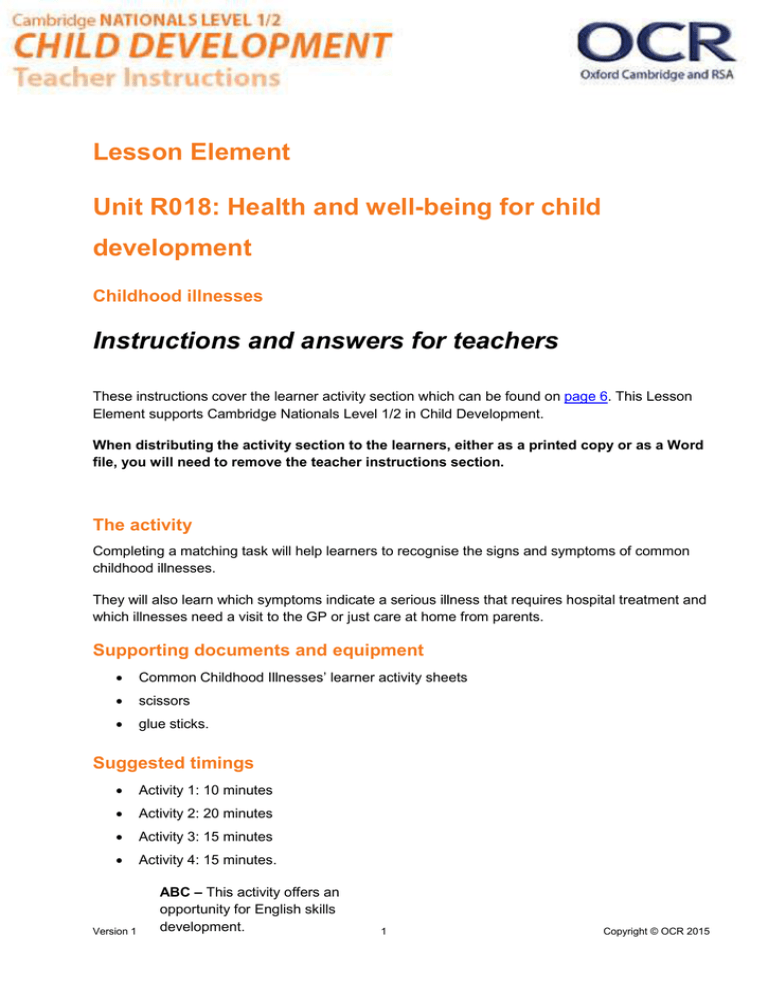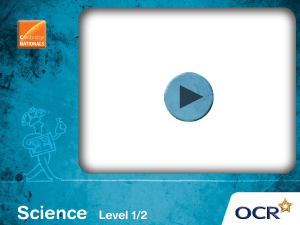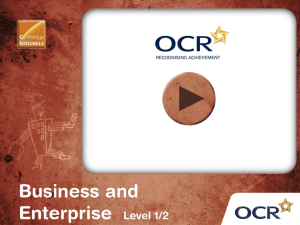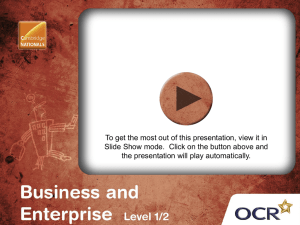Unit R018 - Lesson element - Childhood illnesses (DOC, 683KB)
advertisement

Lesson Element Unit R018: Health and well-being for child development Childhood illnesses Instructions and answers for teachers These instructions cover the learner activity section which can be found on page 6. This Lesson Element supports Cambridge Nationals Level 1/2 in Child Development. When distributing the activity section to the learners, either as a printed copy or as a Word file, you will need to remove the teacher instructions section. The activity Completing a matching task will help learners to recognise the signs and symptoms of common childhood illnesses. They will also learn which symptoms indicate a serious illness that requires hospital treatment and which illnesses need a visit to the GP or just care at home from parents. Supporting documents and equipment Common Childhood Illnesses’ learner activity sheets scissors glue sticks. Suggested timings Activity 1: 10 minutes Activity 2: 20 minutes Activity 3: 15 minutes Activity 4: 15 minutes. Version 1 ABC – This activity offers an opportunity for English skills development. 1 Copyright © OCR 2015 Definitions Signs of illness: Changes that occur when a child is becoming ill, for example: loss of appetite, becoming ‘clingy’, crying, lethargic. Symptoms of illness: Conditions, such as: vomiting, diarrhoea, high temperature, breathing difficulties, fitting, develops a rash, unresponsive. Activity 2 Provide scissors for the learners to cut out the boxes of signs and symptoms. Explain to your learners that they should match the signs and symptoms with the illnesses listed in the chart. Check the answers with your learners before providing them with a glue stick to fix them down in the signs and symptoms column on the chart. Version 1 2 Copyright © OCR 2015 Common Childhood Illnesses Illness Mumps Signs and symptoms Treatment (Activity 2) (Activity 3) Pain, swelling of the jaw in front of the ears, fever. Take to G.P. for diagnosis. Then home care. Rest, fluids, painkillers that are age appropriate for the child. Pain when eating and drinking. Phone G.P. to confirm diagnosis. Measles High fever, fretful, white spots inside mouth followed by blotchy rash on body. Discharge from eyes. Common cold Sneezing, sore throat, running nose, headache. Home care. Damp cotton wool to clean the eyes. Paracetamol or Ibuprofen to relieve fever. Plenty of fluids. Home care. Treat symptoms i.e. headache, sore throat. Fluids only for 24 hours. Food poisoning Meningitis Vomiting, diarrhoea and abdominal pain. Headache, fever, neck stiffness and joint pains, small red spots. If child is very young or if symptoms are severe or continue for more than 12 hours, see G.P. Take to hospital A&E for emergency treatment. Inability to tolerate light. Chickenpox Slight fever, red itchy rash, child feels ill, severe headache. Home care. Rest, fluids, cut child’s nails to prevent scratching the rash and causing secondary infection. Use Calamine lotion to ease itching. Tonsillitis Very sore throat, fever, headache, pain on swallowing, aches and pains in back and limbs. Take to G.P. for antibiotics. Then home care, rest, fluids. Cold drinks to reduce pain. Version 1 3 Copyright © OCR 2015 Activity 3 Put your learners into groups or pairs for this task. Explain that for each of the illnesses they have to decide what type of care is required: only care at home needs to be seen by a G.P. requires emergency treatment at a hospital. Tell them that they will need to be prepared to share decisions with the rest of the class. Teachers should facilitate discussion of the learners’ decisions. When consensus is reached learners should complete the treatment column in their table of childhood illnesses. Activity 4 Learners should now apply their knowledge of childhood illnesses to complete the lists on their activity sheet. They should give three examples for each. Signs that a child is ill: loss of appetite becoming ‘clingy’ continuous crying lethargic/listless irritable/fretful quieter than usual. Symptoms of an illness: vomiting diarrhoea high temperature/fever breathing difficulties fitting developing a rash unresponsive. Version 1 4 Copyright © OCR 2015 When to call an ambulance: if a child stops breathing if the child has breathing difficulties severe or persistent vomiting and/or diarrhoea symptoms of meningitis cannot be woken appears to have severe abdominal pain if the child has a fit for the very first time unconscious/unaware of what is going on. When to take the child to the G.P. if mumps is suspected if measles is suspected for tonsillitis that requires antibiotics vomiting/diarrhoea if child is very young. We’d like to know your view on the resources we produce. By clicking on ‘Like’ or ‘Dislike’ you can help us to ensure that our resources work for you. When the email template pops up please add additional comments if you wish and then just click ‘Send’. Thank you. If you do not currently offer this OCR qualification but would like to do so, please complete the Expression of Interest Form which can be found here: www.ocr.org.uk/expression-of-interest OCR Resources: the small print OCR’s resources are provided to support the teaching of OCR specifications, but in no way constitute an endorsed teaching method that is required by the Board, and the decision to use them lies with the individual teacher. Whilst every effort is made to ensure the accuracy of the content, OCR cannot be held responsible for any errors or omissions within these resources. © OCR 2015 - This resource may be freely copied and distributed, as long as the OCR logo and this message remain intact and OCR is acknowledged as the originator of this work. OCR acknowledges the use of the following content: Maths and English icons: Air0ne/Shutterstock.com Please get in touch if you want to discuss the accessibility of resources we offer to support delivery of our qualifications: resources.feedback@ocr.org.uk Version 1 5 Copyright © OCR 2015 Health and well-being for child development Learner Activity Childhood illnesses Completing these tasks will help you to understand the signs and symptoms of common childhood illnesses. You will know which symptoms indicate a serious illness that requires hospital treatment and which illnesses just need care at home from parents or a visit to the G.P. Activity 1 Before you start to think about childhood illnesses in detail it is useful for everyone to agree a definition of the difference between a ‘sign’ and a ‘symptom’ of an illness. Discuss with a partner a definition of a ‘sign’ and of a ‘symptom’ of illness. Share your definitions with the whole class and then definitions that everyone has agreed upon can be recorded below. Definitions Signs of illness: __________________________________________________________ __________________________________________________________ __________________________________________________________ __________________________________________________________ Symptoms of illness: __________________________________________________________ __________________________________________________________ __________________________________________________________ __________________________________________________________ Version 1 6 Copyright © OCR 2015 Activity 2 Cut out the boxes of signs and symptoms shown below. Match them with the illnesses listed in the ‘Common Childhood Illnesses’ chart you have been given. Check the answers with your teacher before sticking them down in the signs and symptoms column on the chart. Headache, fever, neck stiffness and joint pains, small red spots. Sneezing, sore throat, running nose, headache. Inability to tolerate light. Vomiting, diarrhoea and Slight fever, red itchy rash, child feels ill, severe headache. abdominal pain. Pain, swelling of the jaw in front of the ears, fever. Very sore throat, fever, headache, pain on swallowing, aches and pains in back and limbs. Pain when eating and drinking. High fever, fretful, white spots inside mouth followed by blotchy rash on body. Discharge from eyes. Version 1 7 Copyright © OCR 2015 Common Childhood Illnesses Illness Version 1 Signs and symptoms Treatment (Activity 2) (Activity 3) 8 Copyright © OCR 2015 Activity 3 Your teacher may put you into groups or pairs for this task. For each of the illnesses decide what type of care is required: only care at home needs to be seen by a G.P. requires emergency treatment at a hospital. Be prepared to discuss your decisions with the rest of the class. When agreement is reached fill in the ‘treatment’ column in your table of childhood illnesses. Activity 4 Based on what you have learned about childhood illnesses, complete the lists below. Give three examples for each. Signs that a child is ill: _____________________________________________________ _____________________________________________________ _____________________________________________________ Symptoms of an illness: _____________________________________________________ _____________________________________________________ _____________________________________________________ Version 1 9 Copyright © OCR 2015 When to call an ambulance: _____________________________________________________ _____________________________________________________ _____________________________________________________ When to take a child to the G.P. _____________________________________________________ _____________________________________________________ _____________________________________________________ Version 1 10 Copyright © OCR 2015






